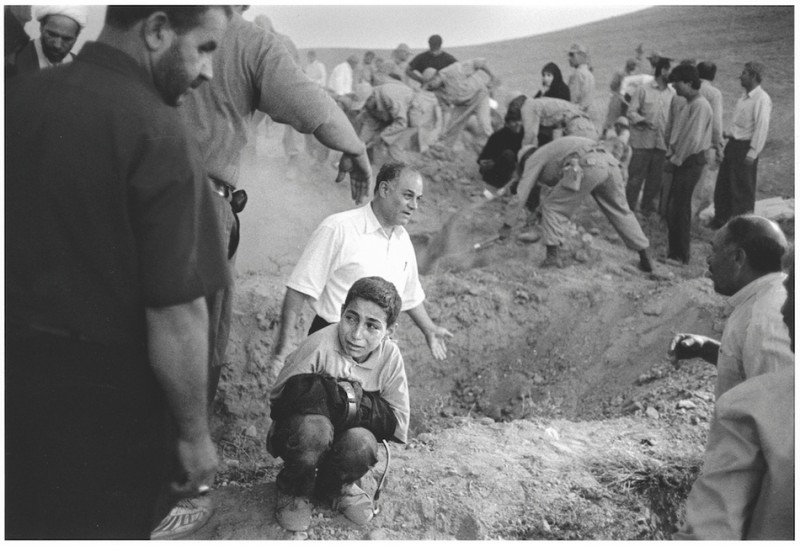11th September 2002. I was at Heathrow Airport, flying home to Dhaka. Friends had warned me against flying that day, but I wasn’t too bothered and looked forward to the empty seats I could stretch out on. In place of the flight notices, the loudspeakers made an unusual announcement. It was a call for a minute’s silence for the people who died at the World Trade Centre and year ago. A minute’s silence, and then it was business as usual.

The piece that follows was written in February 2003, in the week following the judging of World Press. Before the invasion of Iraq, before the advent of embedded journalism. Later at the award ceremony at the Oude Kurk, I was impressed by Wolffensperger’s speech (Chairman of the Board, World Press Photo), made in the presence of the Dutch Prime Minister, where he clearly stated his position regarding the attack on journalists and the media coverage during the invasion. I was left wondering however, why we as a community have never called for that minute’s silence, for those killed in Afghanistan or in Iraq, or the industry’s silence on the killing of its workers. We are responsible for the words that we speak, and the images we produce. Who will take the responsibility for the silences we maintain?
——————————————————————–
Much is made of the figures, but this is not a numbers game. While the sheer volume of photographs is daunting, it is still in the end a qualitative choice. How does one weigh one photograph against another? What makes one compelling image more special than another? What criteria do juries use to determine which one is best?
The parameters for the World Press Photo of the year are known; a photograph showing outstanding visual qualities and representing a news situation of global importance. News photographs are often taken on the run, in situations of extreme stress, often in situations of danger. Only outstanding photographers are able to create powerful, moving, beautifully constructed images even under such conditions. But their qualities need to combine with outstanding news-value to create the most talked about press image of the year.
2002 was a year of waiting. Waiting for UN resolutions to be applied equally to all. Waiting for aggressors to be punished. Waiting for a war that the world abhorred but seemed unable to stop. Missing were the moments that news networks paid millions to cover. Disasters in western countries lacked significant death tolls. Nothing significant had happened in the countries that mattered.
That is not to say that nothing had happened, or that the world was at peace. In a world where all lives are not equal, some lives are easily forgotten. Their daily plight does not count. Their struggles are insignificant. No war machines come to their rescue. Unless material interests intervene.
But riots, earthquakes and indiscriminate bombings have taken place, and occupation continues. And there have been photographers who have been there. At a time when defence pools, restricted access, and editorial policy define the perimeters of journalism, some photographers have gone against the grain and covered stories which should have been news but weren’t, about people who should have mattered but didn’t.
Clinging to the trousers of his dead father, a young boy cries for a loss that is as universal as it is personal. The image talks of humankind’s eternal struggle against nature, and a community’s ability to stand by the afflicted. Yet, amidst all these people, the young man is alone in his misery. The death he mourns might not matter to a world that doesn’t care, but to him, the world might well have stopped. And one photograph preserved that moment, a silent witness of an emptiness that speaks to us all. One photographer takes on the challenge of questioning our definitions of news.
As for the judging itself, it was a complex, passionate, fervent affair. Time and time again, we were humbled by someone’s insight into a moment, that had completely passed us by. Again and again, our zone of comfort was invaded. We were shaken into responding to an argument that questioned the values that we had always considered unshakeable. Our tools of measurement were cast aside. We stood naked, our prejudices exposed.
The photographers too stretched us. Images that explored the gaps in our visual spaces, played with our sense of balance. War was presented through lingering traces. Political systems presented through emptiness and solid structures. Consumerism and decadence exposed through garish images, unashamedly rejecting the classical norms of image construction. Tender moments rendered without sentimentality. And of course those stark images, where the photojournalist, at the right place at the right time, but hopefully for not too long, returned with the horrors of what man does to man.
When the credibility of our media, shrouded in propaganda, struggles for survival, a few brave women and men continue to report the news that is no longer newsworthy. This contest salutes their courage.
Shahidul Alam
21st February. Oldham.
Chairman of the Jury 2003
